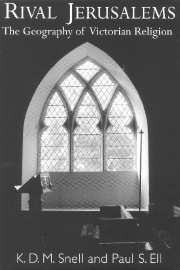Book contents
- Frontmatter
- Contents
- List of figures
- List of tables
- Preface and acknowledgements
- Introduction
- Part 1 Religious geographies: the districts of England and Wales
- 1 The 1851 Census of Religious Worship
- 2 The Church of England
- 3 Old dissent: the Presbyterians, Independents, Baptists, Quakers and Unitarians
- 4 The geographies of new dissent
- 5 Roman Catholicism and Irish immigration
- 6 Denominational co-existence, reciprocity or exclusion?
- Part 2 Religion and locality: parish-level explorations
- Technical appendices
- Bibliography
- Index
1 - The 1851 Census of Religious Worship
Published online by Cambridge University Press: 08 August 2009
- Frontmatter
- Contents
- List of figures
- List of tables
- Preface and acknowledgements
- Introduction
- Part 1 Religious geographies: the districts of England and Wales
- 1 The 1851 Census of Religious Worship
- 2 The Church of England
- 3 Old dissent: the Presbyterians, Independents, Baptists, Quakers and Unitarians
- 4 The geographies of new dissent
- 5 Roman Catholicism and Irish immigration
- 6 Denominational co-existence, reciprocity or exclusion?
- Part 2 Religion and locality: parish-level explorations
- Technical appendices
- Bibliography
- Index
Summary
Introduction
On Sunday 30 March 1851, for the first (and last) time as part of the decennial population census, questions were asked about the religious composition of Great Britain.
Despite the unique importance of the resulting Census of Religious Worship, it has received remarkably little sustained analysis. Quite a number of articles, and edited works on particular counties, have assessed its reliability and used it to describe basic patterns of worship, but this book is the first to enter into thorough investigation of it. A number of considerations have inhibited prior analysis. Foremost among these have been the awesome scope of the source, its highly quantitative nature, and the inter-disciplinary skills and facilities necessary to undertake such a study. There have also been problems concerning the measures needed for the source, and doubts have sometimes been expressed about the accuracy of some of its details. Religious studies as a subject has been slow to adopt the quantitative methods necessary to analyse the census. And linked to this has been a feeling that its data are of limited relevance for studies of religion which concentrate on belief and faith, rather than external action and attendance at services.
However, for the most part objections and hindrances of these kinds can now be overcome. The 1851 data can be checked via internal statistical tests and managed in ways which surmount doubts about their accuracy.
- Type
- Chapter
- Information
- Rival JerusalemsThe Geography of Victorian Religion, pp. 23 - 53Publisher: Cambridge University PressPrint publication year: 2000



